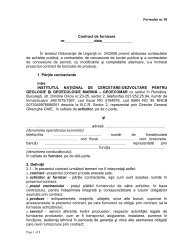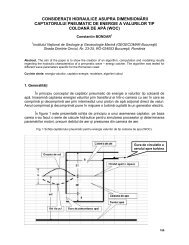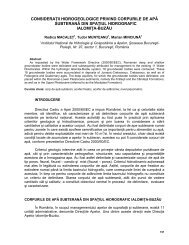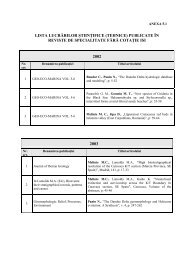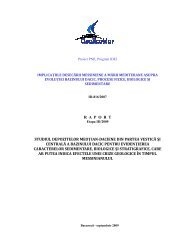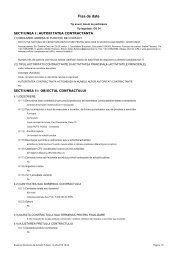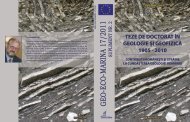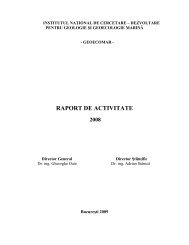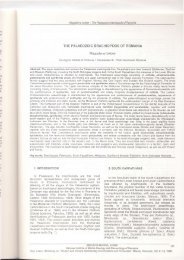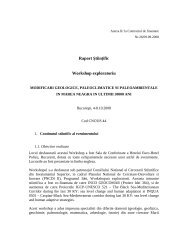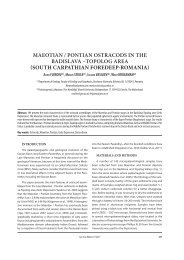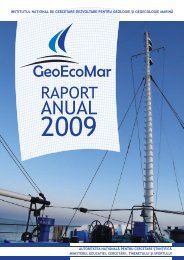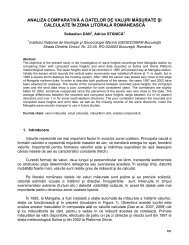global changes, sea level rising and the danube delta - GeoEcoMar
global changes, sea level rising and the danube delta - GeoEcoMar
global changes, sea level rising and the danube delta - GeoEcoMar
Create successful ePaper yourself
Turn your PDF publications into a flip-book with our unique Google optimized e-Paper software.
N. Panin - Global Changes, Sea leyel Rrsing <strong>and</strong> <strong>the</strong> Danube Delta<br />
of <strong>the</strong> <strong>sea</strong> <strong>level</strong> strongly influenced <strong>the</strong> Danube Delta spit", <strong>the</strong> <strong>delta</strong>-front advanced beyond <strong>the</strong> present-day<br />
<strong>and</strong> its coastline evolution. The WUrmian regressions, shoreline by 10-15 km.<br />
<strong>and</strong> especially that of <strong>the</strong> Neoeuxinian stage of <strong>the</strong> Black 4. At <strong>the</strong> same time (3,500-1,500 yr. BP) in <strong>the</strong><br />
Sea (<strong>the</strong> minimum at about 18,000 yr. BC), when <strong>the</strong> sou<strong>the</strong>rn part of <strong>the</strong> <strong>delta</strong> area, a little secondary <strong>delta</strong> -<br />
<strong>sea</strong> <strong>level</strong> lowered to -130 + -150 m, brought about <strong>the</strong> <strong>the</strong> "Cosna-Sinoie Delta", was formed by a secondary<br />
intense erosion of much of <strong>the</strong> older Quaternary <strong>delta</strong> distributary named DunavSt. lts front line prograded at<br />
deposits. One can still recognise some remnants of least by 5 km offshore from <strong>the</strong> present shoreline.<br />
<strong>the</strong>se older deposits (assigned to Karangatian <strong>and</strong><br />
Surojskian), preserved behind some relics of <strong>the</strong> 5. The next phase (-2,800 yr. BP - present) is<br />
pre<strong>delta</strong>ic relief. The present-day Danube Delta edifice represented by <strong>the</strong> formation of two new <strong>delta</strong>ic lobes:<br />
(tens to 300-400 m thickness of detritai deposits) was "Kilia Delta" in <strong>the</strong> North, built up by a new Danube<br />
<strong>the</strong>refore formed mainly during <strong>the</strong> Upper Pleistocenedistributary<br />
- Kilia, <strong>and</strong> "St" George ll Delta" in <strong>the</strong> South,<br />
(Karangatian, Surojskian, Neoeuxinian) <strong>and</strong> especially corresponding to a reactivation of <strong>the</strong> $t. George<br />
during <strong>the</strong> Holocene (Panin et al., 1983).<br />
distributary. By <strong>the</strong>n <strong>the</strong> Sulina distributary was partly<br />
The development of <strong>the</strong> Danube Delta during <strong>the</strong> clogged <strong>and</strong> <strong>the</strong> Sulina Delta gradually eroded. Thus,<br />
Holocene time is marked by <strong>the</strong> following main phases during <strong>the</strong> last -2,800 yr. <strong>the</strong> new lobes have prograded<br />
(Panin ef a/., 1983; Panin, 1989, 1998) (Fig.1, 2): by 16-18 Km, while Sulina Delta coast line regressed by<br />
about 10-12 km. The same process of erosion <strong>and</strong> coast<br />
1. "Letea-Caraorman initial spit" phase (11,700- regression (by few km) has been recorded at <strong>the</strong><br />
7,500 yr.BP): <strong>the</strong> coastline was represented by a spit "Cosna-Sinoie Delta" within <strong>the</strong> Portita-Periboina section<br />
located at <strong>the</strong> entrance into <strong>the</strong> "Danube Gulf' at about of <strong>the</strong> littoral zone.<br />
25-30 km West of <strong>the</strong> present <strong>delta</strong> shoreline;<br />
2. The first <strong>delta</strong> of <strong>the</strong> River Danube - "St.<br />
George I Delta" was formed by <strong>the</strong> first Danube<br />
distributary - <strong>the</strong> Paleo-St. George branch in <strong>the</strong> 9,000-<br />
7,200 yr. BP period. In about 2,000 yr. <strong>the</strong> Delta St.<br />
George I has prograded <strong>sea</strong>ward by about I km;<br />
3. The following phase (7,200-2,000 yr. BP) is<br />
represented by <strong>the</strong> development of a new distributary -<br />
Sulina <strong>and</strong> rts <strong>delta</strong>ic lobe - "Sulina Delta". The<br />
maximum progradation was of 30-35 km from <strong>the</strong> "initial<br />
Table 1 Main characteristics of <strong>the</strong> River Danube water <strong>and</strong> sediment discharqes<br />
3. PRESENT.DAY STATE OF THE DANUBE<br />
DELTA COASTALZONE<br />
3.1 Processes <strong>and</strong> dynamic factors controlling<br />
<strong>the</strong> <strong>delta</strong> coastline morphology <strong>and</strong> development<br />
a. River Danube water <strong>and</strong> sediment input<br />
The following table characterises <strong>the</strong> River Danube<br />
water <strong>and</strong> sediment discharges during 1840-1990 period<br />
at <strong>the</strong> entrance into <strong>the</strong> <strong>delta</strong> territory (Bondar ef a/_,<br />
2000).<br />
Characteristic values<br />
Mean multiannual discharoe<br />
Mean annual maximum discharoe <strong>and</strong> date<br />
Mean annual minimal discharse <strong>and</strong> date<br />
Maximum dailv discharoe <strong>and</strong> date<br />
Water Q<br />
6.283 m'/s (198.3 km'/vr.)<br />
9.420 m"/s in 1941<br />
3.160 m'/s in 1863<br />
20,940 m'/s in 07.1897<br />
Sediment discharqe R<br />
1,737 kals (54.8 M Vvr.)<br />
4.780 kois in 1871<br />
224ko/s in 1990<br />
Minimum dailv discharoe <strong>and</strong> date 1.350 m"/s in 10.1921<br />
The sediment discharges presented in <strong>the</strong> Table 1<br />
resulted from a mediation of values measured before<br />
<strong>and</strong> after lron Gate I <strong>and</strong> ll dams building. The average<br />
annual suspended sediment discharge before <strong>the</strong> dams<br />
building was 2,140 Kg.s-' (67,5 mittions Vyr), out of<br />
which s<strong>and</strong>y alluvia ca. 10% (Almazov ef a/., 1963;<br />
Stangik ef a/., 1 988).<br />
After '1970, originates mainly in <strong>the</strong> sediments eroded from <strong>the</strong> river<br />
bottom.<br />
b. Meteorological factors - wind system<br />
consequently to <strong>the</strong> building of lron<br />
Gates I dam (Km.942,95 from <strong>the</strong> Black Sea) <strong>and</strong>,<br />
especially after <strong>the</strong> lron Gates ll (Ostrovul Mare) dam<br />
(Km 864) building in 1983, <strong>the</strong> sediment discharge<br />
decreased catastrophically (Fig. 3): at present, one can<br />
estimate that <strong>the</strong> Danube total average sediment<br />
discharge could not be larger than 35 - 40 million Uyr.,<br />
out of which less than 4 million Uyr. is s<strong>and</strong>y material<br />
(Panin, 1996). This is <strong>the</strong> only amount of s<strong>and</strong>y<br />
sediments contributing yearly to <strong>the</strong> littoral zone<br />
sedimentary budget, which since 1970 became strongly<br />
uncompensated. lt is also obvious that <strong>the</strong> present day<br />
coarse sediment load (bed load) of <strong>the</strong> Danube<br />
The western <strong>and</strong> north-western areas of <strong>the</strong> Black<br />
Sea basin are zones of active atmospheric circulation,<br />
being situated at <strong>the</strong> interference of <strong>the</strong> routes of Aflantic<br />
<strong>and</strong> Polar, Mediterranean <strong>and</strong> Euro-Asian air masses.<br />
Thus, winds exceeding 2mls are recorded for 80-g0% of<br />
a year, winds exceeding 6 m/s for 30-55% <strong>and</strong> those<br />
exceeding 11 m/s tor 4-15o/o. Prevaiiing winds are from<br />
<strong>the</strong> nor<strong>the</strong>rn sector (40-50%); <strong>the</strong> nor<strong>the</strong>rn winds are<br />
also <strong>the</strong> strongest. The frequency <strong>and</strong> duration of storms<br />
from <strong>the</strong> nor<strong>the</strong>rn sector are clearly predominant (more<br />
than 55%).<br />
c. Sea <strong>level</strong> <strong>and</strong> subsidence<br />
The Delta is situated in an area of high mobility of <strong>the</strong><br />
Earth crust, repeatedly affected by strong subsidence<br />
GEO-ECO-MARINA.<br />
4/1 999<br />
National lnstitute of Marine Geology <strong>and</strong> Geo-ecology<br />
Proc' lntern. Workshop on "Modern <strong>and</strong> Ancient Sedimentary Environmeiis <strong>and</strong>processej; in Maeciu, Romanla, oct, g-15. 199g



